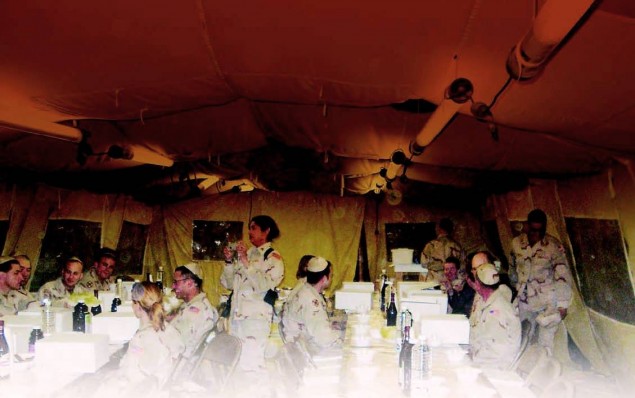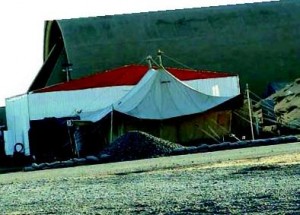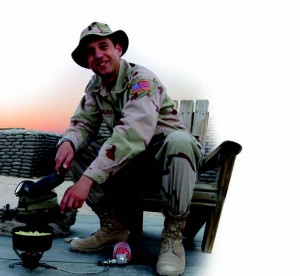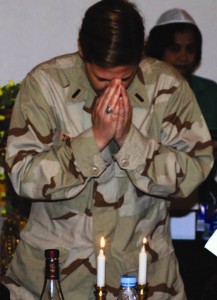Pesach on the Base
 Preparing for a seder in Balad, Iraq, 2004. Courtesy of the Unit Ministry Team
Preparing for a seder in Balad, Iraq, 2004. Courtesy of the Unit Ministry Team
PESACH IN IRAQ
One week after US forces toppled Saddam Hussein’s tyrannical regime in April 2003, Jews everywhere gathered around their Seder tables to celebrate Pesach. Inside an army tent in the desert outside Baghdad, twenty-five Jewish American soldiers–scruffy, tired and elated from their mission–huddled close together. For them, it was truly a night different from all others and one they will never forget.
“On erev Pesach we had a horrible sandstorm,” recalls Chaplain (Major) Carlos Huerta. “You couldn’t see ten feet in front of you. But it cleared by sundown and we had a wonderful Seder.” Rabbi Huerta, who was ordained at Yeshiva Or HaTorah in Jerusalem, has been a chaplain for sixteen years (nine of them at the United States Military Academy at West Point; he is currently serving at Fort Benning, Georgia).
Weeks before Pesach, the division chaplain sent word about the Seder. Jewish military chaplains got busy preparing for Pesach in the middle of a war. “Here we were ready to invade Iraq,” says Rabbi Huerta. “Everyone’s checking their weapons, and I’m in the back of a moving truck making sure all my matzot are covered with three plastic bags so that they’ll survive [the mission].”
Obtaining kosher for Passover food was challenging at the time. Chaplain (Captain) David Goldstrom, a chaplain for nine years who is currently stationed at Fort Drum in upstate New York, flew to Ali Al Salem Air Base in Kuwait to visit soldiers in his unit. The night the war “kicked off,” he arrived with preparations for Pesach on his mind.
“There was no way to get kosher meat,” says the chaplain, who was ordained at Ohr Somayach, in Monsey, New York. “I had this idea that pretty much anywhere in the world one could find fresh fish.”He asked an air force services officer to procure a few whole salmon on ice. He held the Seders with enough salmon for the sixty soldiers, airmen and Marines from the surrounding camps.
“Many of those who came . . . traveled by Humvee and helicopter and on foot. These soldiers risked their lives for the sole purpose of being with other Jews at a Seder.”
“At that point in the war, we didn’t have to put on our gas masks or chemical suits,” says Rabbi Goldstrom. “Two weeks earlier, we were sleeping in our protective chemical gear. When we got to the end of the Seder and said ‘L’shanah haba’ah b’Yerushalayim,’ more than any other Pesach in my life, I felt it.”
Chaplains elsewhere in Iraq at the time faced the same kosher-for-Passover-food dilemma. “The majority of our meals consisted of fruits and vegetables, and a few cans of tuna and gefilte fish,” says Chaplain (Colonel) Mitchell Ackerson, fifty-two, an army reservist for twenty-five years who led a Seder near the Iraq/Kuwait border. Since there is a long-established US air base in Kuwait, he turned to the base for better provisions. With free access to the warehouse, he was able to procure fruits and vegetables and even managed to get a few new pots and knives as well as a cutting board. “We threw butcher paper on the table and cut everything up, put it all in baggies and stuck the baggies in a footlocker,” he says.
DISCOVERING JUDAISM WHILE DEPLOYED
The military Seder has offered many assimilated Jewish servicemen and servicewomen a vital introduction to their religion. “They walk away not just with full bellies or with a couple of tunes in their heads. They walk away with a heightened Jewish awareness and, in some cases, reconnected,” says Chaplain (Major) Shmuel Felzenberg, a chaplain for more than a decade who is currently at West Point. A graduate of Yeshivas Tomchei Tmimim in Kfar Chabad, Israel, the forty-two-year-old chaplain has led Seders in Iraq and Afghanistan.
Chaplain (First Lieutenant) Moshe Lans, a reserve soldier for sixteen years, was called up on active duty to Iraq in 2006, just before Pesach. A chaplain assistant at the time, Rabbi Lans sat down to a Seder along with forty Jewish soldiers in Saddam Hussein’s hunting lodge. “We took a place of such darkness and evil and turned it around by performing mitzvot there,” says Rabbi Lans, who received semichah from Pirchei Shoshanim, based in Lakewood, New Jersey.
“The place was packed,” says Laurie Zimmet, a lieutenant in the US Navy who participated in the Seder and is currently stationed in Washington, DC. “Many of those who came, who weren’t necessarily stationed at the base, traveled by Humvee and helicopter and on foot. These soldiers risked their lives for the sole purpose of being with other Jews at a Seder.”
In 2007, Rabbi Goldstrom led a Seder in Tikrit, 100 miles northwest of Baghdad on the Tigris River. By that time, thanks to the input of the Jewish military chaplains, the army was supplying Jewish servicemen with “Seder kits.” Each kit came equipped with a Seder plate, a zeroah, charoset, marror, a pound of matzah, a matzah cover, a Kiddush cup, a Hebrew/English Haggadah, boxes of grape juice, jars of kosher-for-Passover gefilte fish, kosher-for-Passover MREs [meals, ready to eat], and a white kittel and yarmulke. The kits were drop-shipped by helicopter to designated locations.
“Jewish soldiers are what the Army calls ‘low density’ . . . .We’re not concentrated in one place; there’s one, maybe two in a unit. The rare opportunities when [we] get together with other Jewish soldiers are extremely meaningful,” says Rabbi Goldstrom.
Many soldiers are surprised to see “so many” other Jewish military men around the table, and from such varied backgrounds. “We’ve had folks asking the Four Questions in Hebrew, English, Spanish, French, Russian, Ukrainian and Hungarian,” says Rabbi Ackerson. “They love coming together.”
 Chapel at Contingency Operating Base (C.O.B.) Speicher in Tikrit, northwest of Baghadad on the Tigris River, in Iraq. Courtesy of Chaplain David Goldstrom/US Army
Chapel at Contingency Operating Base (C.O.B.) Speicher in Tikrit, northwest of Baghadad on the Tigris River, in Iraq. Courtesy of Chaplain David Goldstrom/US Army
For many soldiers, the Seder evokes dormant memories. “I may be sitting with a forty-year-old air guard who remembers that the last time he had an experience like this was when he was eleven, sitting at his grandfather’s table,” says Rabbi Felzenberg. “The experience can move even a combat-hardened warrior to tears.”
“The first Pesach I was in Afghanistan, [I saw] the typical twentytwo- year-old wise guy, who isn’t afraid of anything, break down,” says Chaplain (Colonel) Ira Kronenberg, who retired in 2008 after thirty-seven years in the military. “When I asked him to recite the Mah Nishtanah at the Seder, he started crying. He told me, ‘I’ve been in Afghanistan for nine months, and this is the first time I’m crying. ’He said the Seder reminded him of his grandfather’s Seder.”
Aside from arousing nostalgia, the Seder also piques the participants’ curiosity, as it was designed to do. “I’m up till one or two in the morning answering questions,” says Rabbi Ackerson. “Soldiers want to know about God, the meaning of the Bible, why it is such a problem to marry someone who isn’t Jewish. I’ve even been asked if I can help find shidduchim for them. I help them understand that being a Jew in the US military is not inconsistent; [Judaism promotes the idea of ] bringing freedom and democracy to others. Many of them had never heard Judaism spoken about that way.”
“Jewish soldiers are what the Army calls ‘low density’ . . . .We’re not concentrated in one place; there’s one, maybe two in a unit. The rare opportunities when [we] get together with other Jewish soldiers are extremely meaningful.”
Stephen Goldenberg experienced his first and “best” Pesach in 2008 in one of Hussein’s palaces. While on an MiTT (military transition team–a group of ten to fifteen soldiers who train local forces), living among Iraqis, he “put in his paperwork” saying he wanted to participate in Passover services. “I was just starting to explore Judaism at the time,” says Goldenberg, who is now stationed in Fort Bliss, Texas and regularly attends an Orthodox synagogue in El Paso. “[That Pesach] was a wonderful experience. The rabbi held prayer services and a couple of the guys started crying. We had some rounds coming in the [second] night; we stopped for a minute and when it was all clear, we went back to the Seder. I felt privileged to be alive and to be able to celebrate Pesach.”
Pesach, perhaps more than any other yom tov, speaks to a Jewish soldier. “[I think] it’s the challenges of going to war, the separation from loved ones,” says Rabbi Ackerson. “They want that connection to home, family, Am Yisrael. All that comes forward when a soldier goes to war. The soldiers remember that Seder [held during wartime] for the rest of their lives.”
FINDING THE AFIKOMAN IN OKINAWA
Chaplain (Lieutenant) Kevin Scott Bemel discovered that putting together a kosher Seder in Okinawa, Japan, was a far cry from pre-Pesach shopping in Los Angeles, his stateside home. The forty-nine-year-old Navy chaplain, who received semichah from Pirchei Shoshanim in Lakewood, New Jersey, sees to the religious needs of Jewish US servicemen throughout the Western Pacific. He has been serving in Okinawa, home base for the Third Marine Expeditionary Force, since 2006. According to Rabbi Bemel, the next closest rabbi is a civilian in Tokyo. Being the sole Jewish presence in the area, he wasn’t surprised that his first Pesach Seder drew close to half of the sixty Jews who live in the region.
“Unlike the Army and Air Force, the Department of Navy has tighter budgetary restrictions [on holiday provisions],” says Rabbi Bemel. He didn’t let that daunt him; he simply rallied his “domestic troops,” organizing a small Pesach committee comprised of four military wives, the chapel staff and himself. The crew got busy cleaning as he tracked down food for the Seder.
“Fortunately, there were some Passover supplies in the commissary, our grocery store,” he says. “I got some freshly caught fish at the local fish market and got hold of some Pesach kits containing the matzot and bitter herbs. Using whatever resources we had, we cobbled together a Seder.”
Despite the fact that most of the participants did not have a Jewish education, he urged everyone to take turns reading from the Haggadah. Three young sailors appeared while the Haggadah was being read; their ship had docked in Japan that day. “They were desperate to be able to celebrate a Seder,” reports Rabbi Bemel. “Someone at the port directed them to the Seder going on at Camp Foster. As the only three Jews on their ship that had been at sea for quite a while, they were ecstatic to be with other Jews for a Seder. It raised everyone’s spirits.”
Passionate about serving as a chaplain, Rabbi Bemel was formerly employed in the commercial real estate field. He turned his life around on September 11, 2001; he was standing in the nation’s Capitol Building when the Pentagon got hit. “It changed my perspective on life,” he says. “I joined the Navy to help sailors and Marines who don’t have their families with them and are so far away from home. Being isolated from other Jews often sparks a need to connect. I become their link to their Jewishness–their source of anything Jewish.”
His second year in Okinawa, Rabbi Bemel held another community Seder. Twenty-eight people participated. “It was very heimishe,” says Rabbi Bemel. “A number of the [servicemen] approached me, saying it was really like being at home; it was what they remembered from when they were children.
“We had conversations going on [around the table] in Spanish, Portuguese, Hebrew and English,” says Rabbi Bemel. “We were a kehillah experiencing Pesach together.”
KEEPING FAITH IN THE JUNGLE
With the inception of the draft lottery in the late 1960s, young men lived in constant dread that their number would be called. In 1969, Dr. Norman Kahan’s number was called; he was going to Vietnam.
 Chaplain David Goldstrom at Ali Al Salem Air Base in Kuwait, using up the last bits of chametz before Pesach in 2003. Courtesy of Chaplain David Goldstrom/US Army
Chaplain David Goldstrom at Ali Al Salem Air Base in Kuwait, using up the last bits of chametz before Pesach in 2003. Courtesy of Chaplain David Goldstrom/US Army
A graduate of Brooklyn Talmudical Academy and New York University Medical School, Captain Kahan, twenty-seven, began his tour of duty in the jungles of the Mekong Delta. He left behind his wife and son, who was less than a year old.
A battalian surgeon, Dr. Kahan was responsible for treating wounded soldiers. “Tragically, there was often very little for me to do other than send them out via helicopter, but I had to be there,” he says.
“It was an otherworldly experience,” says Dr. Kahan. “The God of the Western world, where there are toilets that flush, didn’t exist in that dark part of the universe. You’re out in the jungle where no one cares if it’s Thursday or Friday; it’s just one day after another melding into one.”
In the midst of the gloom, Dr. Kahan heard that there would be a Passover Seder in Long Binh. He received permission to attend and welcomed the jeep ride out of the Delta, looking forward to a semblance of yom tov.
Arriving in Long Binh, he met Major Mendy Ganchrow, MD, a fellow Orthodox officer who was serving as an army combat surgeon for an evacuation hospital in the area. “He put me up in living quarters that were palatial compared to where we were,” Dr. Kahan recalls. “We actually slept in beds with a roof over our heads. [Dr. Ganchrow] even had a refrigerator and kosher cheese!”
That Pesach, 400 Jewish soldiers celebrated the season of our freedom in an unused hospital wing. Soldiers from bases and field posts across the region sat together at long tables lined with matzot, wine and hundreds of TV dinners (provided by the Jewish Welfare Board). “It was a great feeling to be sitting there and observing the holiday, in relative comfort, with fellow Jews,” says Dr. Kahan.
“Even though the vast majority of the soldiers were non-observant, some had never even been to a Seder before, no one in the room seemed impatient about sitting through an Orthodox Seder,” says Dr. Ganchrow, who years later served as a president of the Orthodox Union. Dr. Ganchrow led the Seder (pinch-hitting for the unit chaplain, who was recuperating from a bout with laryngitis) and remembers the soldiers’ rousing singing of Dayeinu, a song most of them found comfortingly familiar. “Many of the men probably absorbed more Yiddishkeit in those two hours than they had in years,” he says.
 Laurie Zimmet, a liutenant in the US Navy, participated in a Seder held in Saddam Hussein’s hunting lodge in 2006. Here she is seen in Iraq, lighting candles to welcome Pesach. Courtesy of Laurie Zimmet
Laurie Zimmet, a liutenant in the US Navy, participated in a Seder held in Saddam Hussein’s hunting lodge in 2006. Here she is seen in Iraq, lighting candles to welcome Pesach. Courtesy of Laurie Zimmet
The sound of incoming enemy rocket fire broke the revelry. “We knew instantly what it was,” says Dr. Ganchrow. “One of the first things a soldier learns upon entering the Vietnam war zone is to distinguish between the powerful thud of outgoing mortars and the sinister whistle of an incoming missile.” The sirens wailed, signaling everyone to crawl to an underground bunker until the all-clear sounded. Dr. Ganchrow announced, “I give you my solemn word that God will not allow harm to befall you if you perform the mitzvah of finishing the Seder.” No one left the room.
At the Haggadah’s conclusion, the chaplain (hoarse voice and all) and Dr. Ganchrow linked arms and spontaneously danced around the table singing “L’shanah haba’ah b’Yerushalayim.” Soon everyone in the room joined them; many of the soldiers had tears streaming down their faces. “Men were unashamedly hugging each other,” recalls Dr. Ganchrow. “It was emotionally overwhelming to join with hundreds of American GIs in the distant jungles of Vietnam, professing our shared love for far-off Jerusalem.”
That Seder undoubtedly strengthened the morale and spiritual strength of every one of the soldiers present. Dr. Kahan, who admits to struggling with his faith while in Vietnam, counts himself among those who were deeply affected. “[In Vietnam] I saw the worst side of human nature,” he says. “I saw mortally injured men dying in front of me . . . . But partaking in a religious ceremony, the Pesach Seder, with other Jews in that battle area was a very moving experience–one I will never forget.”
Bayla Sheva Brenner is senior writer in the OU Communications and Marketing Department.
